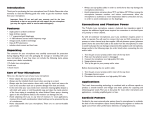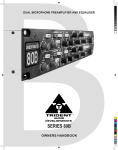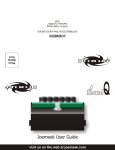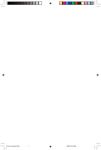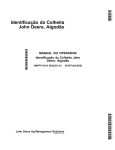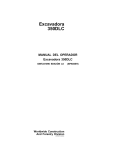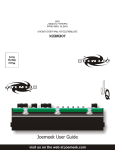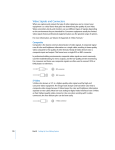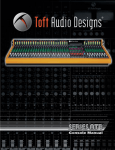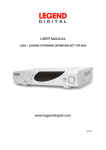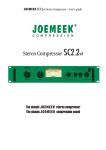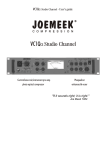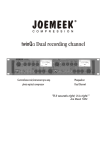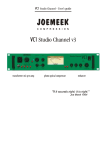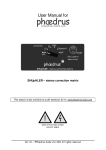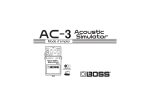Download C1 Manual - Studio Projects
Transcript
C S E R I E S M I C R O P H O N E S • Professional Studio Microphones • Transformerless circuitry • Large diameter pressure gradient capsule employing 6 um gold sputtered Mylar diaphragms • Low-noise FET Preamplifier • Dual Triode “6072” hand tested tubes (T3 Only) • Multi-Pattern variable power supply (T3 Only) • Heavy duty road case (All Models) • Elastic heavy duty shock mount (All Models) Studio Projects is manufactured and marketed under the direction of: PMI AUDIO GROUP USA: 1845 W. 169th Street, Gardena, California 90247 voice: (310) 323-9050 facsimile: (310) 323-9051 toll-free USA: (877) 563-6335 UK: Unit 2 Babbacombe Business Park Babbacombe Road, Torquay, Devon TQ1 3SY tel: +44 (0) 1803 329848 C u c t s Pb F d d L e a email: [email protected] tifie er d r e e o P r visit our web site at studioprojects.com c_series_manual.indd 2-3 Studio Projects® Instruction Manual 1/17/07 5:07:58 PM StudioProjects 2 INSTRUCTION BOOK CONTENTS What is Studio Projects?...................................................................................................2 Guidelines For Proper Care/Use ......................................................................................2 Electrical Features…........................................................................................................3 Operation………………………………………………….................................................4 Troubleshooting Tips…………………………………………………..........………………5 Origins and manufacture.................................................................................................6 Applications....................................................................................................................6 C1..................................................................................................................................7 C3......................................................................................................................................8 T3..................................................................................................................................9 C4..................................................................................................................................10 LSD2................................................................................................................................11 WHAT IS STUDIO PROJECTS? Based in Gardena, California, Studio Projects is a line of microphones and electronics started in 1999 by Alan Hyatt of PMI Audio Group. Our line of award winning microphones and preamps is a result of a partnership between PMI Audio and Beijing 797 Audio Co. LTD. a manufacturer of condenser microphones and professional audio products since 1952. Within the line, there is a broad and evolving range of tools designed to provide the engineer and recordist with a level of sonic quality and durability. Studio Projects continues to prove that innovative designs and years of experience produces quality products that fit well in all professional and home applications. If you have any questions or issues at any time, please feel free to contact us by phone or email, or log on to our web forum at http://www.pmiaudio.com/forums/. GUIDELINES FOR PROPER CARE/USE Large capsule capacitor mics such as the Studio Projects C-series, are built to handle a fairly substantial degree of abuse. However, one should always consider their investment and treat these mics with delicacy. The capsule itself is by far the most easily damaged component within the microphone. The biggest threat to a capsule is moisture and high humidity. A capsule corrupted by moisture, will lose sensitivity and exhibit a rumbling sound. This is due to the water molecules condensing within the very small gap between the diaphragm and backplate. When this occurs, the two plates cannot properly maintain their electrical charge. The result is that the microphone may become unusable and require repair. Since it is a lot more fun to make recordings than to send your mic to us for servicing, please consider the following: • Improper vocal recording technique is the primary cause of moisture-related capsule failure. Breathing on the transducer will cause the mylar diaphragm to immediately fog up. If this occurs repeatedly over time, the capsule will most likely short out. c_series_manual.indd 4-5 3 www.studioprojects.com This may seem a bit ironic, since the microphones are intended for vocal use, but with proper care and technique, these problems can be avoided. One easy way to prevent moisture from reaching the capsule is to put some distance between the vocalist and the microphone. A distance of six to twelve inches is acceptable. It is common to see stage performers singing directly into the grill of a handheld unit, but these are generally dynamic microphones, which are much more robust and employ an entirely different operating principle - which is not nearly so susceptible to moisture. Additionally, large diameter capacitor microphones are quite sensitive. It is not necessary to get right up on the grill. Doing so may in fact result in artifacts such as sibilance and popping. For reference, it may be of help to look up a picture of Frank Sinatra or Billie Holiday to observe how these legends placed themselves in relation to their microphones. • A pop filter is a device, used as an additional layer of protection between vocalist and microphone. Ideally suited for this purpose is the Studio Projects part# SP-MPF. Additional benefits of the use of a pop filter are the reduction of plosives and sibilance. Studio Projects recommends the use of a pop filter for all vocal work where vocalist and microphone are in close proximity. • Provided with all Studio Projects microphones is a zipper pouch or hard shell case. When not in use, storing the microphones in these provided accessories will help to protect them from moisture, dust, scratches and dents. • A foam windscreen is included with each microphone for use in conditions where wind may interfere with sound pickup. To use, simply slide windscreen over microphone grill. Verify that microphone is properly oriented towards sound source, as it is harder to see which way the mic is facing once the windscreen is in place. • In the event of the microphone exhibiting loss of signal and or rumbling noise, place it in a warm, low humidity environment, such as the middle of the Sahara desert at high noon, or preferably several inches beneath an incandescent light bulb. This will help to remove any moisture. If problems persist, please contact Studio Projects directly using the contact information found in this manual. Electrical features The C1, C3, C4 & LSD2 require +48-volt phantom power to operate. Verify that your gain device (preamp, mixing console, etc.) provides this feature. Both microphones are solid state devices with externally polarized transducers, FET impedance conversion circuitry and active outputs. Their individual circuit topologies provide low noise and high sound pressure handling capabilities. The T3 employs a separate power supply, which provides power to the microphone. The impedance circuitry is vacuum tube based with externally polarized transducer. The output is balanced, employing a humbucking transformer. The circuit topology provides very high sensitivity, low noise and high sound pressure handling capabilities. 1/17/07 5:07:59 PM StudioProjects 4 OPERATION C1 Using a male to female 3-pin XLR cable, plug microphone in to gain device (preamp, mixing console, etc.), making sure that +48-volt phantom power is active and gain is not at a level sufficient to cause ear-splitting feedback through monitor speakers. Address microphone from the side (not the top of the grill) above the SP logo badge. If bass cut is required, select one of two featured high pass filters. 150Hz setting will attenuate low frequencies by 6dB/ octave starting at 150Hz. 75Hz. Setting will attenuate low frequencies by 6dB/octave at 75Hz. The “pad” switch reduces the signal level between the capsule and the circuitry. Engage -10dB or -20dB pad for very high sound pressure levels, which may otherwise overload microphone circuitry, causing distortion. C3 Using a male to female 3-pin XLR cable, plug microphone in to gain device (preamp, mixing console, etc.), making sure that +48-volt phantom power is active and gain is not at a level sufficient to cause ear-splitting feedback through monitor speakers. Address microphone from the side (not the top of the grill) above the SP logo badge. If bass cut is required, select 150Hz high pass filter. The “pad” setting reduces the signal level between the capsule and the circuitry. Engage -10dB pad for very high sound pressure levels, which may otherwise overload microphone circuitry, causing distortion. Use the three-way switch on the front of the C3, below the SP logo, to adjust the directional characteristics of the microphone between omnidirectional, cardioid and figure of eight: • Omnidirectional (O-shaped nomenclature): Sound from all directions is picked up by microphone without any side or rear attenuation. • Cardioid (Heart-shaped nomenclature): Some attenuation of sound occurs on sides and rear of microphone. • Figure of eight: Very significant attenuation of sound pickup on sides of microphone. Front and rear of microphone pick sound up equally, but 180° out of phase from one another. T3 Plug power supply into ac receptacle. Connect 3-pin male to female XLR cable to output jack on front of power supply. Use included 7-pin XLR cable to connect microphone to power supply. Ensuring that gain device (mixing console, preamp, etc.) is not at a sufficient level to cause ear-splitting feedback. Turn on microphone power supply. Address microphone from the side (not the top of the grill) above the SP logo badge. *Note – Power supply has 110v/240v switch. Ensure that switch is set to proper AC voltage for your region. This switch is set at the factory at the time of manufacture according to region, but a microphone purchased used, for instance, may have the incorrect voltage setting. *Another note – The presence of or lack of +48- volt phantom power will not affect operation of T3. c_series_manual.indd 6-7 5 www.studioprojects.com C4 Using a male to female 3-pin XLR cable, plug microphone in to gain device (preamp, mixing console, etc.) of course, all the while making sure that +48-volt phantom power is active and gain is not at a level sufficient to cause ear-splitting feedback through monitor speakers. Address microphone towards the grill mesh in the top of the microphone. Included with all C4 microphone pairs are two sets of capsules: two cardioid ( the ones with the holes around the circumference) and two omnidirectional (no holes around circumference). The threaded capsules may be changed by simply unscrewing one capsule and screwing another on to the amplifier body. Since the threads are delicate, take particular care not to “cross thread” the capsules during installation. It will not harm the microphone to change the capsule while still plugged in, but it will make a horrendous noise, so it is always best to perform this operation while the mic is unplugged, or the mic level is at minimum. If bass cut is required, select one of two featured high pass filters. 150Hz setting will attenuate low frequencies by 6dB/octave starting at 150Hz. 75Hz. Setting will attenuate low frequencies by 6dB/octave at 75Hz. The “pad” switch reduces the signal level between the capsule and the circuitry. Engage -10dB or -20dB pad for very high sound pressure levels, which may otherwise overload microphone circuitry, causing distortion. LSD2 Using the included 7-pin to dual 3-pin XLR breakout cable, plug microphone into 2channel gain device (preamp, mixing console, etc.), making doubly sure that +48-volt phantom powers are active and gain is not at a level sufficient to cause ear-splitting feedback through monitor speakers. Address microphone from side (not the top of the grill). The switches used to control the upper capsule are located on the front of the microphone above the SP logo badge, while the control switches for the lower capsule are found on the rear of the mic. If bass cut is required, select 150Hz high pass filter. The “pad” setting reduces the signal level between the capsule and the circuitry. Engage -10dB pad for very high sound pressure levels, which may otherwise overload microphone circuitry, causing distortion. Adjust upper grill by grasping and turning. It’s that simple! Further application information regarding the LSD2 can be found at the Studio Projects website: www.studioprojects.com/downloads.html TROUBLESHOOTING TIPS No Sound Whatsoever: All C-series microphones require external voltage in order to operate. Verify that +48-volt phantom power (C1,C3,C4 & LSD2) is present. For T3, ensure that power supply is properly connected and power is on. Still No Sound (C1,C3,C4 & LSD2): Make sure microphone cable is XLR male to XLR female and connect only to inputs labeled “Mic In”, or “Microphone”, etc. The Back Of My C3/T3 Sounds Different From The Front When Set To Figure Of Eight: Are you monitoring with headphones while talking into the mic? If so, the back of the mic will sound strange. This is because the rear diaphragm of the microphone takes the sound of your voice and flips it 180° out of phase. Meanwhile, the lower frequency range of your voice travels in phase along your jaw line to your ears. When the out of phase signal from the headphones meets the in-phase signal from your ears, the two signals are phase cancelled. Since this effect only occurs during the conditions described above, it will not affect recordings. 1/17/07 5:08:00 PM StudioProjects 6 www.studioprojects.com TROUBLESHOOTING TIPS cont... C1 Shockmount Looks As If It Should Fit On Mic Stand, But For Some Reason, It Will not Screw On: There are two standard thread sizes for mic stands, 5/8-27 and 3/8-16. Studio Projects shockmounts ship with a brass reducer installed, which allows for the 3/8-16 threads. For use with 5/8- The Studio Projects C1 is an externally polarized cardioid pressure gradient transducer microphone with FET impedance converter. Diaphragm material is 6µm mylar for natural reproduction of vocals and instruments. It features dual selectable pads and high pass filters for a total of nine possible modes of operation. The output circuitry is active and is capable of driving long cable runs. The C1 is useful for all manner of recording work and music styles. 27 mic stand threads, unscrew adapter from shockmount, using a small coin as a screwdriver. Keep track of adapter when not in use – you never know when you may need it… ORIGINS AND MANUFACTURE Studio Projects Microphones are manufactured in Beijing, China by 797 Audio to a specification defined by Studio Projects, Gardena, California. All Studio Projects microphones are inspected and tested at the factory, then inspected and tested again at PMI Audio Groups facility prior to shipping. Studio Projects microphones meet the requirements of electronic equipment sold both in the USA, Canada, and the European Union. APPLICATIONS • Close miking of instruments with high sound pressure levels • Announcer’s mic for broadcasting/dubbing • Home recording and project studios • Vocalist recording • Spot mic for: wind instruments, strings, percussion and guitar amps. • XY - Coincident Cardioids • Mid-Side Method • Stereosonic Technique (Blumlein) • Overheads C1 SPECIFICATIONS Type: Single diaphragm pressure gradient condenser microphone Polar pattern: Cardioid. Frequency response: 30Hz~20000Hz. Sensitivity: Output impedance: 14mV/Pa=-37dB (0dB=1V/Pa). <200 Ohm. Load impedance: >1000 Ohm. Max. SPL: 131 dB SPL for 1% THD @1000Hz (0dB SPL=0.00002Pa). Noise: (Line): 27 dB (A weighted) ---17 dB. S/N ratio: 77 dB. Power requirement: 48 +/- 4V. Current consumption: <2.5mA. Circuit: JFET impedance converter, discrete balanced output. Connector: Gold-plated 3-pin XLR Pad: -10dB, -20dB Low Cut: 6dB/octave at 75Hz or 150Hz Diameter: 2.1” length: 8.9” Weight: c_series_manual.indd 8-9 7 26.9oz 1/17/07 5:08:01 PM StudioProjects 8 www.studioprojects.com C3 T3 The Studio Projects C3 is an externally polarized cardioid pressure gradient transducer microphone with FET impedance converter. Diaphragm material is 6µm mylar for natural reproduction of vocals and instruments. It features a selectable pad and high pass filters as well as three directional pattern settings: omnidirectional, cardioid and figure of eight. The output circuitry is active and is capable of driving long cable runs. The C3 is useful for all manner of recording work and music styles. The Studio Projects T3 is an externally polarized cardioid pressure gradient transducer microphone with a vacuum tube based impedance converter. Diaphragm material is 6µm mylar for natural reproduction of vocals and instruments. The T3 features a humbucking output transformer for balancing the microphone signal and driving long cable runs. C3 SPECIFICATIONS Type: 1 inch large dual diaphragm FET condenser microphone. Polar pattern: Cardioid/omni directional/figure of 8. Frequency response: Included with the microphone is a shockmount, external power supply with AC cord, dedicated 7pin XLR cable, and hard shell road case. T3 SPECIFICATIONS Type: Large dual diaphragm vacuum tube microphone. 30Hz~20000Hz. Polar pattern: Cardioid/ omni directional /figure 8 and 6 intermediate stages. Sensitivity: 12mV/Pa=-38dB (0dB=1V/Pa). Frequency response: 20Hz~20000Hz. Output impedance: <200 Ohm. Sensitivity: 14mV/Pa=-37 dB (0dB=1V/Pa). Load impedance: >1000 Ohm. Output impedance: Max. SPL: 132/142/152dB SPL for 1% THD @1000Hz Load impedance: Noise: (Line) ---28 dB (A weighted)---18 dB. S/N ratio: 76 dB. Power requirement: 48 +/- 4V. Current consumption: <2.5mA. Circuit: JFET impedance converter, discrete balanced output Connector: Gold-plated 3-pin XLR. Pad: -10dB, -20dB Low Cut: 6dB/octave at 75Hz or 150Hz Diameter: 2.1” length: 8.9” Weight: 26.9oz c_series_manual.indd 10-11 9 Max. SPL: Noise: S/N ratio: <250 Ohm. >1000 Ohm. 125dB SPL for 1% THD @1000Hz (0 dB SPL=0.00002Pa). (Line) ---28 dB (A weighted)---18 dB-A. 76 dB. Power requirement: Supplied Power Supply (SPT3) 110/220 Circuit: vacuum tube impedance converter, balanced transformer output Current: 200V DC high voltage, <1.5mA Filament: 6.3V DC, <370mA. Connector: Diameter: Weight: Gold-plated 7-pin XLR 2.1” length: 8.9” 26.9oz 1/17/07 5:08:02 PM 10 StudioProjects www.studioprojects.com C4 LSD2 The C4 is a 20mm diameter condenser microphone featuring interchangeable capsules, linear, low-noise, solid-state electronics, selectable -10dB/20dB pads and selectable 150Hz/75Hz high pass filters. It is intended for all-around use on stage, on location and in studios of all calibers. The LSD-2 is a stereo microphone comprised of two separate dual-membrane solid state microphones contained within a single housing. Its capsules are mounted in close proximity on a vertical axis - the upper capsule assembly having the ability to rotate 270 degrees horizontally, relative to the lower capsule. Two C&K three-way switches control the polar response, high pass filtering and -10dB pad for each capsule (The switches on the front of the body correspond to the lower fixed capsule, while the switches 180° opposite on the back of the mic control the rotating upper capsule). It is the combination of capsule articulation and independent pattern switching which allows a user of the LSD2 to achieve all manner of coincident pair stereophonic recording techniques. Due to the close proximity of the capsules, there is no phase cancellation resulting from time delay between the two signals. This translates into excellent mono compatibility. Used as an omnidirectional (pressure) microphone, the C4 offers a warm tonal response and is recommended for close miking in favorable acoustical environments. There is very little off axis coloration owing to the inherent nature of pressure capsules, and it is this - combined with the low self-noise of the mic circuitry that makes the C4 omni an excellent ambience mic –especially in pairs. In a good room, a pair of omnis can provide a vibrant and live feel to recordings, which is not achievable through the use of directional microphones. The C4 omni is intended for all manner of recording tasks, including vocal, piano and orchestral use. As a cardioid (pressure gradient) microphone, the C4 provides excellent pickup of on-axis sources while attenuating extraneous sound occurring from the side and rear of the mic. This makes it ideal for close miking of individual instruments where bleed from other nearby instruments or sound is undesirable. The C4 cardioids also make excellent stereo pairs for coincident and near-coincident miking techniques such as X-Y and ORTF. Additionally the C4’s are quite useful on a drum kit as overheads and on toms, not to mention snare drum. The inner workings of the LSD-2 are essentially that of two Studio Projects Model C3 microphones. The capsules are 1.06” (27mm) diameter, dual membrane, Braunmuhl-Weber design. These are independently coupled through low-noise amplifiers based on FET driven discrete balanced output stages. The outer housing is plated brass with a single layer brass wire mesh grill surrounding the capsules. Included with the LSD-2 microphone is a dedicated 7-pin XLR to dual 3-pin XLR “Y” cable, magnum-sized foam windscreen, standard shockmount and carrying case. For increased side and some rear attenuation, the hypercardioid head (HC1) is available for the C4 microphone. This pressure gradient capsule is particularly useful for X-Y, ORTF, speech and dialog pickup, drum overheads and spot miking. LSD2 SPECIFICATIONS The C4 microphone set is offered in pairs with mic stand clips (C4SC), foam windscreens (C4WS), stereo bar (SPSB) and hard shell carrying case. Type: Stereo condenser microphone with vertically coincident 1.06” (27mm.) dual diaphragms. C4 SPECIFICATIONS Polar pattern: Cardioid, Omni directional Figure of 8 Frequency response: 30~20000Hz. Sensitivity: 12mV/Pa=-38dB(0dB=1V/Pa). Output impedance: <200 Ohm. Load impedance: >1200 Ohm. Max. SPL: 132/142dB SPL for 1% THD @1000Hz(0dB/-10dB pad, 0dB SPL=0.00002Pa). Noise: (Line)---28 dB (A weighted)---18 dB-A. S/N ratio: 76 dB. Circuit: JFET impedance converter, discrete balanced output Type: Polar pattern: Frequency response: Sensitivity: Output impedance: Load impedance: Max SPL: Equivalent Noise: S/N ratio: Power requirement: Current consumption: Circuit: Connector: Pad: Low cut: Length: Diameter: Weight: c_series_manual.indd 12-13 20mm diameter condenser microphone with FET impedance converter. Omni-directional pressure (OC1 head), pressure gradient cardioid (CC1 head), pressure gradient hypercardioid (optional HC1 head) 20Hz – 20kHz -39dB/-39dB/-38dB <200 Ohm. >1200 Ohm. 158 dB SPL with -20dB pad 18 dB SPL, (A-weighted per IEC268-15). 76/76/77dB P48 +/- 4V 3.1ma JFET follower, low distortion output buffer Gold-plated 3-pin XLR. -10dB/-20dB 6 dB/Octave at 75Hz/150Hz 4.90”(124.5mm) .787” (20mm) 3.3oz. (92g)s 11 Power requirement: 24v.-52.5v. phantom power x 2 Current Consumption: 2.5mA Connector: Gold-plated 7-pin XLR breakout cable Size: 2.1” (53.34mm.) dia. Weight: 1.8 lbs. 1/17/07 5:08:04 PM STATEMENT OF ROHS COMPLIANCE PMI Audio Group manufactures complete electronic products which are covered by the European Union’s “Removal of Hazardous Substances” directive 2002/95/EC (RoHS). This directive seeks to eliminate toxic substances from the manufacturing process, such that when equipment is disposed of at the end of its life cycle, the materials it contains do not contaminate the environment and pose health risks. Banned substances are lead, mercury, cadmium, hexavalent chromium, polybrominated biphenyls (PBB) and polybrominated diphenyl ethers (PBDE). Lead is used together with tin in solder connections to reduce the melting point of solder. Lead-free solder requires higher soldering temperatures which in turn places greater thermal stress on components. PMI Audio Group takes seriously its obligations under the RoHS directive and insists that its factories use only components that are certified RoHS compliant, as well as leadfree solder. In a very few cases the necessary components may not yet be available to the world market but we work continuously to eliminate any such exceptions at the earliest opportunity. Our printed Circuit Boards (PCB’s) and all soldered joints have been lead-free since 2005. STATEMENT OF WEEE POLICY PMI Audio Group manufactures many complete electronic products which are covered by the European Union’s “Waste Electric and Electronic Equipment” directive 2002/96/EC (WEEE). This directive seeks to ensure that waste electric and electronic equipment is disposed of in an environmentally responsible manner, at the end of its life cycle. PMI Audio Group takes seriously its obligations under this directive to take back WEEE-affected products and, from 13th August 2005, will mark all such products with the crossed-out wheeled bin symbol. Business to Business products: PMI Audio Group will cost-neutrally take back WEEE-affected electric and electronic equipment in this category, from 1st January 2006. PMI Audio Group will work with disposal and recycling partners working within the EU. The waste electric and electronic equipment can then be turned over to a disposal and recycling companies in the countries concerned. Business to Customer products: emerging electric and electronic equipment will be disposed of by local authorities’ collection systems. Dual Use products: this equipment will be disposed of by local authorities’ collection systems. IMPORTANT SAFETY INFORMATION CAUTION: TO REDUCE THE RISK OF ELECTRIC SHOCK, DO NOT REMOVE COVER. NO USER-SERVICEABLE PARTS INSIDE. REFER SERVICING TO QUALIFIED SERVICE PERSONNEL. The lightning flash with arrowhead symbol, within equilateral triangle, is intended to alert the user to the presence of uninsulated “dangerous voltage” within the product’s enclosure that may be of sufficient magnitude to constitute a risk of electric shock to persons. The exclamation point within an equilateral triangle is intended to alert the user to the presence of important operating and maintenance (servicing) instructions in the literature accompanying the appliance. WARNING: TO AVOID FIRE OR ELECTRIC SHOCK HAZARD, DO NOT EXPOSE THIS APPARATUS TO WATER, RAIN OR MOISTURE. c_series_manual.indd 14-15 This appliance has a serial number located on the rear panel. Please record the model number and serial number and retain them for your records. Model number Serial number NOTE — This apparatus does not exceed the Class A/Class B (whichever is applicable) limits for radio noise emissions from digital apparatus as set out in the radio interference regulations of the Canadian Department of Communications. ATTENTION — Le présent appareil numérique n’émet pas de bruits radioélectriques dépassant las limites applicables aux appareils numériques de class A/de class B (selon le cas) prescrites dans le réglement sur le brouillage radioélectrique édicté par les ministere des communications du Canada. These limits are designed to provide reasonable protection against harmful interference in a commercial/residential installation respectively. This equipment generates, uses, and can radiate radio frequency energy and, if not installed and used in accordance with the instruction manual, may cause harmful interference to radio communications. There is no guarantee that interference will not occur in a particular installation. If this equipment does cause interference to radio or television equipment reception, which can be determined by turning the equipment off and on, the user is encouraged to try to correct the interference by any combination of the following measures: (1) Relocate or reorient the receiving antenna (2) Increase the separation between the equipment and the receiver (3) Plug the equipment into an outlet on a circuit different from that to which the receiver is connected (4) Consult your dealer or experienced radio/television technician for additional assistance. CAUTION — Changes or modifications to this equipment not expressly approved by the party responsible for compliance could void the user’s authority to operate this equipment. IMPORTANT SAFETY INSTRUCTIONS 1. Read these instructions. 2. Keep these instructions. 3. Heed all warnings. 4. Follow all instructions. 5. Do not use this apparatus near water. Do not expose to drips or splashes. Do not place any objects filled with liquids, such as vases, on the apparatus. 6. Clean only with dry cloth. 7. Do not block any ventilation openings. Do not install this apparatus in a confined space such as a book case or similar unit. Install only in racks designed for the purpose and in accordance with manufacturers’ instructions. 8. Do not install near any heat sources such as radiators, heat registers, stoves, or other apparatus (including amplifiers) that produce heat. 9. Do not defeat the safety purpose of the polarized or grounding-type plug. A polarized plug has two blades with one wider than the other. A grounding-type plug has two blades and a third grounding prong. The wide blade or the third prong are provided for your safety. If the provided plug does not fit into your outlet, consult an electrician for replacement of the obsolete outlet. 10. Protect the power cord from being walked on or pinched particularly at plugs, convenience receptacles, and the point where they exit from the apparatus. 11. Only use attachments/accessories specified by the manufacturer. 12. Use only with a cart, stand, tripod, bracket, or table specified by the manufacturer, or sold with the apparatus. When a cart is used, use caution when moving the cart/apparatus combination to avoid injury from tip-over. 13. Unplug this apparatus during lightning storms or when unused for long periods of time. 14. Refer all servicing to qualified service personnel. Servicing is required when the apparatus has been damaged in any way, such as power-supply cord or plug is damaged, liquid has been spilled or objects have fallen into the apparatus, the apparatus has been exposed to rain or moisture, does not operate normally, or has been dropped. 15. Apparatus designed with Class-I construction must be connected to a mains socket outlet with a protective earthing connection (the third grounding prong). 16. This apparatus may be equipped with a single-pole, rockerstyle AC mains power switch. If so this switch is located on the front panel and should remain readily accessible to the user. 17. The manufacturer reserves the right to change the technical specification of the product without prior notice. 1/17/07 5:08:06 PM NOTES NOTES c_series_manual.indd 16-17 1/17/07 5:08:06 PM STUDIO PROJECTS LIMITED WARRANTY DISCLAIMER OF WARRANTY T H I S P R O D U C T I S F O R P R O F E S S I O N A L U S E O N LY ALL OTHER WARRANTIES, EXPRESS OR LIMITED, INCLUDING, BUT NOT LIMITED TO ANY/OR ALL IMPLIED EXCEPT FOR THE FORGOING WARRANTIES, PMI HEREBY DISCLAIM S AND EXCLUDES WARRANTIES OF MERCHANT ABILITY, FITNESS FOR A PARTICULAR PURPOSE AND/OR ANY WARRANTY WITH PMI Audio Group warrants that all products will be free from defects in material or workmanship: REGARD TO ANY CLAIM OF INFRINGEMENT THAT MAY BE PROVED IN SECTION 2-312(3) OF THE UNIFORM COMMERCIAL CODE AND/OR IN ANY COMPARABLE STATE STATUE. PMI HEREBY DISCLAIMS ANY REPRESENTATIONS OR WARRANTY THAT THE PRODUCT IS A: For a period of (3) years from the date of purchase (hereinafter the labor warranty period), PMI Audio Group will repair or replace this Product if determined to be defective. After the expiration of the labor warranty period, the Purchaser must pay labor charges. B: In addition, PMI Audio Group will supply, at no charge, replacements for defective parts for a period of (3 years) from the date of purchase. During the labor warranty period, to repair the Product, Purchaser must return the defective Product, freight prepaid, or deliver it to PMI Audio Group Service Center. The product to be repaired is to be returned in either its original carton or a similar package affording an equal degree of production. PMI Audio Group will return the repaired Product freight prepaid to the Purchaser. PMI Audio Group is not obligated to provide Purchaser with a substitute unit during the warranty period or at any time. PMI Audio does not Warranty consumables like tubes that wear from normal use. CONDITIONS 1. Notification of claims: Warranty Service: If Purchaser discovers that the Product has proven defective in material or workmanship, then written notice with an explanation of the claim shall be given promptly by Purchaser to PMI but all claims for warranty service must be made within the warranty period. If after investigation PMI determines that the reported problem was not covered by the warranty, Purchaser shall pay PMI for the cost of investigating the problem at its then prevailing time-and-materials rate. No repair or replacement by Purchaser of any Product or part thereof shall extend the warranty period as to the entire Product. The specific warranty on the repaired part only shall be in effect for a period of ninety (90) days following the repair or replacement of that part or the remaining period of the Product warranty, whichever is greater. 2. Exclusive Remedy: Acceptance: Purchaser’s exclusive remedy and PMI’s sole obligation is to supply (or pay for) all labor necessary to repair any product found to be defective within the warranty period and to supply, at no extra charge, new or rebuilt replacements for defective parts. If repair or replacement fails to remedy the defect, then and only in such an event, shall PMI exchange to Purchaser a new or reconditioned unit. Purchaser’s failure to make a claim as provided in paragraph 1 above or continued use of the product shall constitute an unqualified acceptance of such Product and a waiver by Purchaser of all claims thereto. 3. Exceptions to Limited warranty: PMI shall have no liability or obligation to Purchaser with respect to any Product subjected to abuse, improper use, negligence, accident, modification, failure of the end-user to follow the operating and maintenance procedures outlined in the users manual, attempted repair by non-qualified personnel, operation of the unit outside of the published environmental and electrical parameters, or if such products original identification (trademark, serial number) markings have been defaced, altered, or removed. PMI excludes from warranty coverage, Products sold AS IS and/or WITH ALL FAULTS and excludes used products which have not been sold by PMI to the Purchaser. PMI also excludes from warranty coverage consumables such as fuses and batteries, etc. 4. Proof of purchase: The dealer’s dated bill of sale must be retained as evidence or the date of purchase and to establish warranty eligibility. c_series_manual.indd 18-19 COMPATIBLE WITH ANY COMBINATION OF NON-PMI AUDIO PRODUCTS PURCHASER MAY CHOOSE TO CONNECT TO THE PRODUCT. LIMITATION ON LIABILITY THE LIABILITY OF PMI, IF ANY, AND PURCHASER’S SOLE AND EXCLUSIVE REMEDY FOR DAMAGES FOR ANY CLAIM OF ANY KIND WHATSOEVER, REGARDLESS OF THE LEGAL THEORY AND WHETHER ARISING IN TORT OR CONTRACT, SHALL NOT BE GREATER THAN THE ACTUAL PURCHASE PRICE OF THE PRODUCT WITH RESPECT TO WHICH SUCH CLAIM IS MADE. IN NO EVENT SHALL PMI BE LIABLE TO PURCHASER FOR ANY SPECIAL, INDIRECT, INCIDENTAL, OR CONSEQUENTIAL DAMAGES OF ANY KIND INCLUDING, BUT NOT LIMITED TO, COMPENSATION, REIMBURSEMENT OR DAMAGES ON ACCOUNT OF THE LOSS OF PRESENT OR PROSPECTIVE PROFITS OR ANY OTHER REASON WHATSOEVER. Information in this User Guide is subject to change without notice. No part of this User Guide may be reproduced or transmitted in any form or by any means, electronic, mechanical or by any other means, for any purpose, without the express written permission of PMI Audio Group. PMI Audio Group may have trademarks, copyrights or other intellectual property rights covering the subject matter of this User Guide. Except as expressly provided in any written agreement from PMI Audio Group, the furnishing of this User Guide is provided for the sole use of the authorized User [or Service Agent where applicable] and does not give the User any license to use any trademarks, copyrights or other intellectual property of PMI Audio Group. PMI, PMI AUDIO, TED FLETCHER, MEEQUALIZER, STUDIO PROJECTS, JOEMEEK, TOFT AUDIO DESIGNS, CURRENTSENSE, MEEKROPHONE, TRAKPAK, and (If it Sounds Right...It is Right!) are either registered trademarks or trademarks of PMI Audio Group in the U.S.A. and/or other countries. Copyright © 2006 PMI Audio Group. All rights reserved. OWNERS REGISTRATION CARD T O B E C O M P L E T E D AT T I M E O F P U R C H A S E Name ____________________________________________________ Date of Purchase ____________________________________________________ Serial Number ____________________________________________________ Dealer’s Name ____________________________________________________ R E TA I N F O R Y O U R R E C O R D S P L E A S E D I S PAT C H A N D R E T U R N Y O U R R E G I S T R AT I O N T O S T U D I O P R O J E C T S W I T H I N 1 4 D AY S O F P U R C H A S E 1/17/07 5:08:07 PM Zip Code: 1845 W. 169th Street Gardena, CA 90247 USA STUDIO PROJECTS DISTRIBUTED BY PMI AUDIO GROUP Place Stamp Here PRODUCT REGISTRATION INFORMATION PLEASE FILL IN THE BELOW SECTIONS AND RETURN Name: State: Address: City: Dealer: Date Purchased: email Address: Telephone Number: Model Purchased: Serial Number: Comments: Electronic Musician ❏ EQ ❏ Home Recording ❏ Pro Audio Review ❏ Recording ❏ Pro Sound News What magazines do you read to influence your buying decision: (please check all that apply) ❏ MIX ❏ 1/17/07 5:08:07 PM c_series_manual.indd 20-21










